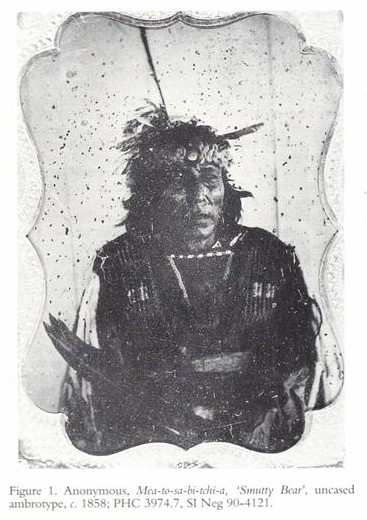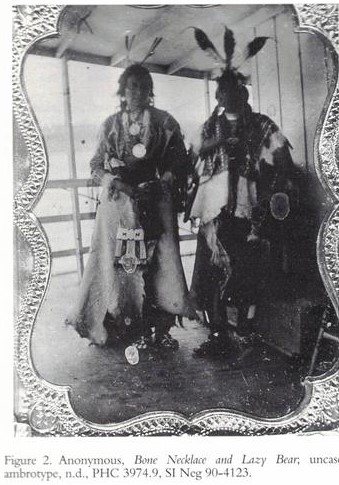An 'Accumulation' of Native American Portraits,
in History of Photography, vol. 24, #1, spring 2000,
National Museum of American History, Smithsonian Institution. ISBN 03087298
An 'Accumulation' of Native American Portraits
Paula Richardson Fleming
On the afternoon of 24 January 1865, the Smithsonian Institution Building was partially destroyed by fire. The 'Castle' suffered extensive damage including the loss of the Gallery of Art, which housed an exhibition of paintings of American Indians. Many were portraits by Charles Bird King, who had been commissioned to paint the Indian delegates visiting Washington, DC, for treaty negotiations with the United States Government.The portraits were painted and subsequently published as lithographs from the 1820s to the 1840s, during photography's infancy. By the time of the fire in 1865, the practice of photography had developed considerably, offering a more immediate imaging medium with multiple applications. Indeed, in 1859 Joseph Henry, the Smithsonian's first Secretary, had proposed that photographs be made of the delegates. The idea lay dormant until the tragic fire, when Henry again suggested that it was time, 'to begin anew.. a far more authentic and trustworthy collection of likenesses of the principal tribes of the US'.
The desire to record Native American portraits was also shared by Ferdinand V. Hayden of the US Geological Survey of the Territories, and William Henry Blackmore, an English philanthropist and entrepreneur. Blackmore provided Hayden with financial support, and he purchased photographs from around the USA for the new endeavour. Blackmore also had Antonio Zeno Shindler and Alexander Gardner photograph the delegates and make glass copy negatives of the images brought from his travels in the West. The results of this collaboration, including a small but significant number of daguerreotypes and ambrotypes, were deposited in the Smithsonian. They formed its first photographic collection as well as its first exhibition of photographs, listed in an 1869 visitor's leaflet known informally as the 'Shindler Catalogue', as he created the list and printed most of the negatives.
These negatives originally were housed in the photographic laboratories of the US Geological Survey and the Bureau of American Ethnology (BAE) at the Smithsonian, and most of the negatives are now in the successor repository, the National Anthropological Archives, located in the National Museum of Natural History. While Blackmore's original paper photographs, mostly cartes-de-visite, were sent to England (most are now in the British Museum), for some unknown reason the cased images remained behind in the USA.
By the turn of the twentieth century, the Smithsonian had grown well beyond the small organization that Blackmore had known, and the Section of Photography had been established. The work of cataloguing and caring for the glass negatives fell to the Institution's photographer Thomas Smillie and later DeLancey Gill of the BAE. As new photographic technologies rendered older processes obsolete, these men had the foresight to retain the early photo forms. By 1932 Gill noted an 'accumulation of daguerreotypes and ambrotypes of American Indians in his office, including those copied by Shindler. Owing to their technical interest as early photographic images, it was considered more appropriate for them to be in a unit devoted to the history of photography rather than being retained in an ethnological section because of their subject matter. Moreover, the BAE held high-quality copy glass negatives and prints made by Shindler of the majority of them, so in effect the originals were curious but redundant. As such, in November 1932, a transfer was made between the BAE and the Section of Photography (now the Photographic History Collection (PHC) in the National Museum of American History). The lot - seventeen daguerreotypes, thirteen ambrotypes, and one tintype - all comprise very carly portraits of Native Americans and all are virtually undocumented.
When Shindler produced his catalogue in the 1860s, he noted when he was the copyist, and dated the images accordingly as his own work. Any original documentation was lost, and subsequent projects to re-catalogue the glass-plate negatives compounded the problems. In the 1950s the BAE made preliminary inquiries concerning the earliest portraits. Several of the original daguerreotypes were found to be by Thomas M. Easterly and the findings were eventually published in 1968. The balance of the photographs, however, remained largely undocumented and a project was initiated in 1970 by the author to correctly identify and credit the original collection of Indian images. During this research, the importance of the early daguerreotypes now in the PHC emerged.
In addition to the Easterly daguerreotypes, there are several portraits of particular note. These are the earliest known photographic portraits of Native Americans made while on a delegation. The delegations were arranged by the US Government not only to negotiate treaties for Indian lands, but also to impress the Indians with the government's power and might. In September 1851, a group of Plains Indians were brought to Washington, DC, where they met President Fillmore, received flags and medals, and visited the Navy Yard and the Arsenal. At one point in their journey they stopped in St Louis where John H. Fitzgibbon made daguerreotypes of several of the Indians. On 30 October 1868, William Henry Blackmore recorded in his diary that he had obtained Indian photographs from Fitzgibbon. Very probably these are the daguerreotypes that were copied by Shindler and now reside in the PHC.
What is of great interest and currently under study is the remaining thirteen photographs that were transferred to the PHC but were neither copied by Shindler nor mentioned in the 1869 catalogue. One such image is an ambrotype of Smutty Bear, a Yankton Dakota. He was part of a large delegation that came to the capital during the winter of 1857-58. Under duress many Native Americans signed a treaty greatly reducing their lands in return for promises of money and provisions that were never fulfilled, prompting the Sioux Revolt of 1862 that killed hundreds of settlers and resulted in the mass hanging of thirty-eight Indians.
 |
Left The portrait of Smutty Bear, (figure 1) probably taken in 1858, is strikingly intimate and technically quite fine. The details of his clothing are especially clear.
Right Equally fascinating is another ambrotype, a portrait of Bone Necklace and Lazy Bear, two Yanktonai Dakotas who appear to be on the deck of a small boat (figure 2). |
 |
At this time one can only speculate what circumstances led them te be
dressed in their finest clothes and photographed while travelling. It is
possible that they, too, are on a delegation, and if so, this would be
the first known image taken of Native Americans actually in transit to
negotiations.
These and the rest of the small accumulation of photographs will form
the basis of an addendum to the Shindler Catalogue, research for which
is currently under way by the author. They serve to illustrate not only
the wealth of resources available in the PHC, but also the connections
and collegial research of various departments within the Smithsonian as
well as with other repositories around the world.